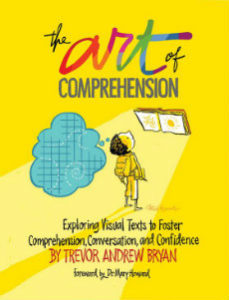Exploring Visual Texts to Boost Comprehension
The Art of Comprehension: Exploring Visual Texts to Foster Comprehension, Conversation and Confidence
By Trevor Andrew Bryan
(Stenhouse, 2019 – Learn more)
 Reviewed by Kevin Hodgson
Reviewed by Kevin Hodgson
It’s hard to resist a book with cover and inside artwork by Peter H. Reynolds, whose picture books The Dot and Ish (and others in his collection) explore the creative spirit with such tenderness and humanity.
 Somehow, Trevor Bryan hit the gold mine. Reynolds’ artwork is situated throughout Bryan’s book – The Art of Comprehension – which delves into how reading visually can be tied to deeper reading all kinds of texts.
Somehow, Trevor Bryan hit the gold mine. Reynolds’ artwork is situated throughout Bryan’s book – The Art of Comprehension – which delves into how reading visually can be tied to deeper reading all kinds of texts.
In fact, one of Bryan’s important observations here is that helping young readers understand more about visual texts, through a series of frameworks, sets the stage for students to learn more about how to approach complex stories, fiction and non-fiction.
Bryan notes that this connection between art and reading emerged during time he spent giving tours to families at an art museum. He began to notice the observation prowess of children, such as one girl he writes about, who “made inferences based on textural evidence, stretched her thinking, used her schema, expressed empathy for one of the characters (in a William Merritt Chase painting), explored different points of view, and made a meaningful text-to-self connection.”
The kicker? The girl was just three and a half years old.
This helped spur Bryan to develop insights into the art/reading connection through a three-tiered process that includes Access Lenses, a series of nine different ways of examining art and images (including facial expressions, sounds/silence, action/non-action, and symbols/metaphors); what he calls the Framework, which is built on a series of questions one might address to dig deeper into what one is seeing, including Listing Everything You See, Determining Theme and Making Connections; and finally, Mood Structures, an idea which forms the crux of the second half of the book.
In fact, the idea of noticing mood in an image, and any other written text, is presented here as a way to help students start talking with each other about what they see (or what they read). They do this by analyzing the way images reflect mood, and the ways stories flow through different modes of moods.
For example, you could track how a character who is sad at one point might find happiness at another. This focus on mood makes sense, for once a reader notices the underlying structure of how mood plays out in a picture book, or a work of art, or in a novel, or even a piece of nonfiction, the reader can then take those insights into their own writing.
Which is where the last part of the book ventures – from how to move from the analysis of a visual, to the reading of a text, shifting further into the writing of a story or narrative with similar attributes – so that the art becomes a mentor text for the writing.
Bryan always retains his focus on the idea of the Art of Comprehension whether in reading or writing, and he argues that toggling back and forth between a widening array of texts – including wordless pictures – with similar structures can be a powerful tool for students to notice a creator’s craft.
Throughout, Bryan brings forward mentor art and stories that can be useful to teachers, regardless of grade level, including some of the more well-known ones by Peter Reynolds. These examples, complete with anchor charts and sample student work, bolster his case that we as teachers need to expand not only our notions of what a text is, but how to teach comprehension skills for all texts, no matter the format or genre, words or no words.
I’ll leave you with this interesting insight from Bryan:
If great books are great works of art, then reading is a form of art appreciation and writing is a form of art creation. From this stance, literacy teachers are really art teachers, without the smocks or carts or dirty, stained hands. – Trevor Andrew Bryan, The Art of Comprehension, page 7
__________________
Kevin Hodgson is a sixth grade teacher in Southampton, Massachusetts, and is Co-Director for Outreach with the Western Massachusetts Writing Project. Kevin blogs regularly at Kevin’s Meandering Mind and tweets more often than is healthy under his @dogtrax handle. For several wonderful years, he wrote a regular blog here at MiddleWeb: Working Draft. He’s welcome back anytime.


































